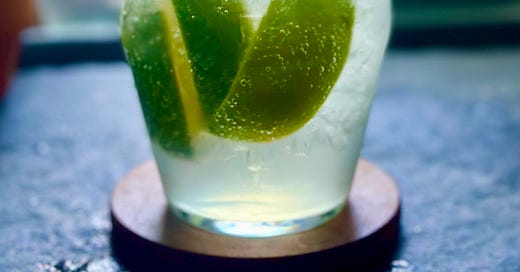Happy Memorial Day!
This week, we’re going to cover a drink so simple, so elemental, you might not think it needs a recipe or a write-up at all. But there are ways to improve even the simplest cocktails.
When internet nerds and bartenders started to rework and rethink old drinks around the turn of the century, little attention was paid attention to the two-ingredient stalwarts of the corner bar that, after reading Michael Ruhlman’s excellent Book of Cocktail Ratios, I have come to think of as “and” drinks. Rum and coke. Scotch and soda. Seven and seven. Mezcal and Mountain Dew. 1
Okay, fine. The last one I made up. But you know what I’m talking about.
The early cocktail renaissance gave little thought to these drinks. They were too basic, too obvious, too simple.
Sure, you could endlessly tweak and refine a three-ingredient drink like Daiquiri or a Manhattan, breaking it down and building it back up again. Obviously, there was mileage in resurrecting some weird old drink no one had heard of that used mysterious ingredients.
But how could you improve a two-ingredient cocktail where all the ingredients were literally in the name?
Today, however, these drinks are back in the mix, and they are more elaborate than ever. Bars like Katana Kitten are making super-rigorous whisky highballs. One of the most celebrated drinks at one of the most celebrated new bars in the country is Superbueno’s Vodka y Soda. Yes, it really is a vodka soda. But it’s a whole lot more than just vodka and soda.
The best of these drinks, however, don’t need any improvement — or they don’t need very much improvement, anyway. They just need a little bit of focus, a little bit of refinement, a little bit of technique.
And when I say “the best,” I obviously mean the Gin & Tonic.
Like Abbot & Costello, like Crusher and Picard, like Turner and Hooch, the Gin & Tonic is a classic combo, practically perfect in every way. As long as the tonic is crisp and the ice is plentiful, it’s hard to go truly, catastrophically wrong with a Gn & Tonic.
But there are some ways to make a Gin & Tonic go much, much more right.
A Cure for What Ails You
The Gin & Tonic began as medicine, with roots in the British colonial era, particularly in India.
British soldiers and officials stationed in India in the 19th century were at risk of malaria. But they learned that quinine, derived from the bark of the cinchona tree, was an effective treatment and preventive measure.
The problem was that it was quite bitter, so not everyone enjoyed consuming it. It was the Campari of its day.
To make the quinine more palatable, British soldiers began mixing it with water, sugar, lime, and gin, making for a sort of boozy limeade. Over time, this mix evolved into the modern Gin & Tonic.
Because it involves just two ingredients, you might think of it as a drink that doesn’t quite live up to the standard cocktail structure, which typically involves a spirit, a sweetener, and something bitter or sour.
But the Gin & Tonic has all of the above. For the spirit you obviously have gin. And then the tonic, which has both sugar and a backbone bitter quinine, covers the rest of the equation. Structurally, it’s a full-fledged cocktail.
Gin & Tonic & Problems
Like I said, most renditions of the Gin & Tonic are pretty good, or at least tolerable. It’s rather difficult to make a version that totally and completely fails.
Some bartenders make homemade versions of tonic water, or swear by some craft brand with a superior quinine flavor. That’s fine as far as it goes. But I think the real problems tend to arise with the balance, the temperature, and the preparation.
Generally speaking, inferior Gin & Tonics tend to have one or more of the following problems:
The drink is too warm or too watery, thanks to too little ice, or ice that was wet and melty before entering the glass. You can avoid this by using freshly crushed, cracked, or pebble ice packed to the top of the glass.
The drink is too strong, thanks to too much gin, or too weak, thanks to too little. You can avoid this by sticking with a consistent ratio. My preference is for 10 parts tonic water to 3 parts gin — which generally means 5 ounces of tonic and 1 1/2 ounces of gin. Conveniently, this allows you to use exactly half a 10-ounce bottle of Schweppes tonic for every drink.
The drink isn’t properly integrated. Somehow the gin seems to be all at the bottom, while your first sip tastes mostly of tonic. You can avoid this by pouring the tonic in first, then adding the gin on top, then giving the mix a very quick stir.
Liiiiiiiime Is on My Side
The very best versions of the drink, however, don’t just avoid all of these traps. They go one step further.
They’re not just cold and crisp and pleasingly balanced. They also taste bright and slightly bitter thanks to the proper incorporation of some lime.
The best Gin & Tonic isn’t just a Gin & Tonic.
It’s a Gin & Tonic — and Lime.
To incorporate the lime, I borrow a trick from the great Tony Cecchini, who makes a gin and tonic by juicing a lime, then slicing the juiced lime hulls into small strips and muddling them, bringing a delightful whiff of lime oil into the mix.
The difference is that I don’t bother juicing the lime first. I just cut it in half, then take one half of the lime and slice it into three wedges. I take those wedges and use a spoon or muddler to muddle them into the bottom of the drink, with special emphasis on rubbing the outside of the lime peels all over the interior of the glass.
Then I fill the glass with small cubes or crushed ice, add tonic, and top it off with gin. For the ratio, as previously noted, I use a 10:3 split, which usually backs out to 5 ounces of tonic and 1 ½ ounces of gin. (This is weaker than Cecchini’s version, but I find it gets the right balance of boozy-to-crisp.)
Yes, I know — muddling citrus wedges will add a bit of lime juice to the mix. You might complain that this takes the drink beyond its two-ingredient name, but the results speak for themselves. And besides, gin and tonics have long used lime wedges for garnish. Many of those lime garnishes have been squeezed into their respective drinks. Why not just go ahead and squeeze them in to begin with?
Not only do you get the aromatic oils from the peel to accent the drink’s nose — almost like the way an absinthe rinse subtly changes the approach of a Sazerac — the tiny bit of lime juice adds acidity and zip to the formula, brightening the mix.
It’s still fundamentally a gin and tonic. But the muddled lime wedges shine a spotlight on the two central ingredients that brings them into greater relief.
Gin & Tonic & Lime
Half lime, sliced into three wedges
1 ½ ounces gin, preferably Tanqueray
5 ounces tonic water
INSTRUCTIONS
Cut a lime in half, then slice the half lime into three wedges.
Using a muddler or spoon, press the wedges against interior walls of a glass.
Fill the glass with small ice or crushed ice, leaving the lime wedges in the glass.
Add tonic, then top the mix with gin.
Garnish with an additional lime wedge, if desired. (Optional.)
Give it a single stir, then enjoy.
Brief programming note: For the next few weeks, I will be much less online than usual, and thus may be quite slow to respond to comments, emails, and so forth. Please converse amongst yourselves!
The Big Gal At Rest
Honestly, mezcal would probably go really well with Surge, the soda I was obsessed with as a teenager.





Add 3 dashes of Ango to this recipe and it makes a different but still wonderfully refreshing cocktail. A pink gin and tonic!
Your ratios are intriguing. I prefer 2:1, while my wife is closer to your ratio, or maybe even 4:1.
Euro Schweppes isn’t bad, but in the US I can’t drink a G&T if it’s not Fever Tree tonic.
Oh yeah—and lime. Lots of lime. But “G & T & L” just doesn’t roll off the tongue the same way, does it?